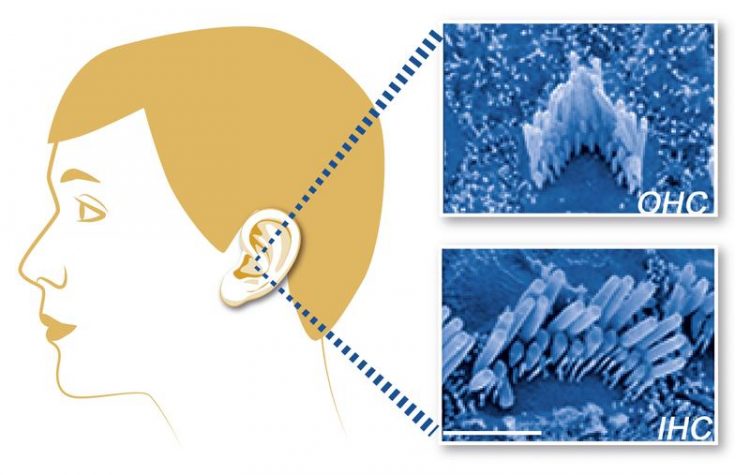Wbp2 is a novel deafness gene

Scanning electron microscopy images of outer (OHC) and inner (IHC) hair cells of the ear of a Wbp2-deficient mouse. EMBO (CC BY 4.0). Adapted from http://embomolmed.embopress.org/cgi/doi/10.15252/emmm.201505523
The scientists have shown that hearing impairment is linked to hormonal signalling rather than to hair cell degeneration. Wbp2 is known as a transcriptional co-activator for estrogen receptor Esr1 and progesterone receptor Pgr.
The loss of Wbp2 causes not only progressive high frequency hearing loss, but also results in reduced expression of Esr1, Esr2 and Pgr in the cochlea – a part of the inner ear. Understanding the estrogen-sensitive molecular networks specific to hearing offers an unprecedented putative new target for the control of the estrogen signalling pathway in the auditory system that could prevent or reverse progressive hearing loss.
“Our study demonstrates that hearing thresholds are normal in young Wbp2 mutant mice, but are raised at high frequencies by four weeks of age,” says EMBO Member Karen Steel of King’s College London, the senior author of the study. “More importantly, we also demonstrate that Wbp2 is crucial for hearing in humans. We found two children affected by severe to profound deafness, each carrying two variants of the WBP2 gene.”
Progressive hearing loss is a very common disease. However, very little is known about its molecular mechanisms. As a result, targets for medical therapies have been lacking. It has been known that estrogen signalling protects against noise-induced hearing loss. However, estrogen-based therapies have not been generally considered for hearing impairment due to their widespread effects. This study opens up the Wbp2 pathway as a new route to therapeutic approaches that more specifically target the inner ear.
Wbp2 was found to be involved in progressive hearing loss during a large-scale screen for hearing defects in newly-generated targeted mouse mutants. The finding of a new gene involved in human deafness following the initial discovery of its role in the mouse also emphasizes the value of mouse genetics research for better understanding human disease.
Wbp2 is required for normal glutamatergic synapses in the cochlea and is crucial for hearing.
Annalisa Buniello, Neil J Ingham, Morag A Lewis, Andreea C Huma, Raquel Martinez-Vega, Isabel Varela-Nieto, Gema Vizcay-Barrena, Roland A Fleck, Oliver Houston, Tanaya Bardhan, Stuart L Johnson, Jacqueline K White, Huijun Yuan, Walter Marcotti, Karen P Steel
Read the paper: http://embomolmed.embopress.org/cgi/doi/10.15252/emmm.201505523
doi: 10.15252/emmm.201505523
Further information on EMBO Molecular Medicine is available at www.embomolmed.embopress.org
Media Contacts
Yvonne Kaul
Communications Officer
yvonne.kaul@embo.org
Céline Carret
Editor, EMBO Molecular Medicine
Tel: +49 6221 8891 411
celine.carret@embo.org
About EMBO
EMBO is an organization of more than 1700 leading researchers that promotes excellence in the life sciences. The major goals of the organization are to support talented researchers at all stages of their careers, stimulate the exchange of scientific information, and help build a European research environment where scientists can achieve their best work.
EMBO helps young scientists to advance their research, promote their international reputations and ensure their mobility. Courses, workshops, conferences and scientific journals disseminate the latest research and offer training in techniques to maintain high standards of excellence in research practice. EMBO helps to shape science and research policy by seeking input and feedback from our community and by following closely the trends in science in Europe. For more information: www.embo.org
http://www.embo.org/news/research-news/research-news-2016/wbp2-is-a-novel-gene-i…
Media Contact
All latest news from the category: Life Sciences and Chemistry
Articles and reports from the Life Sciences and chemistry area deal with applied and basic research into modern biology, chemistry and human medicine.
Valuable information can be found on a range of life sciences fields including bacteriology, biochemistry, bionics, bioinformatics, biophysics, biotechnology, genetics, geobotany, human biology, marine biology, microbiology, molecular biology, cellular biology, zoology, bioinorganic chemistry, microchemistry and environmental chemistry.
Newest articles

Properties of new materials for microchips
… can now be measured well. Reseachers of Delft University of Technology demonstrated measuring performance properties of ultrathin silicon membranes. Making ever smaller and more powerful chips requires new ultrathin…

Floating solar’s potential
… to support sustainable development by addressing climate, water, and energy goals holistically. A new study published this week in Nature Energy raises the potential for floating solar photovoltaics (FPV)…

Skyrmions move at record speeds
… a step towards the computing of the future. An international research team led by scientists from the CNRS1 has discovered that the magnetic nanobubbles2 known as skyrmions can be…





















